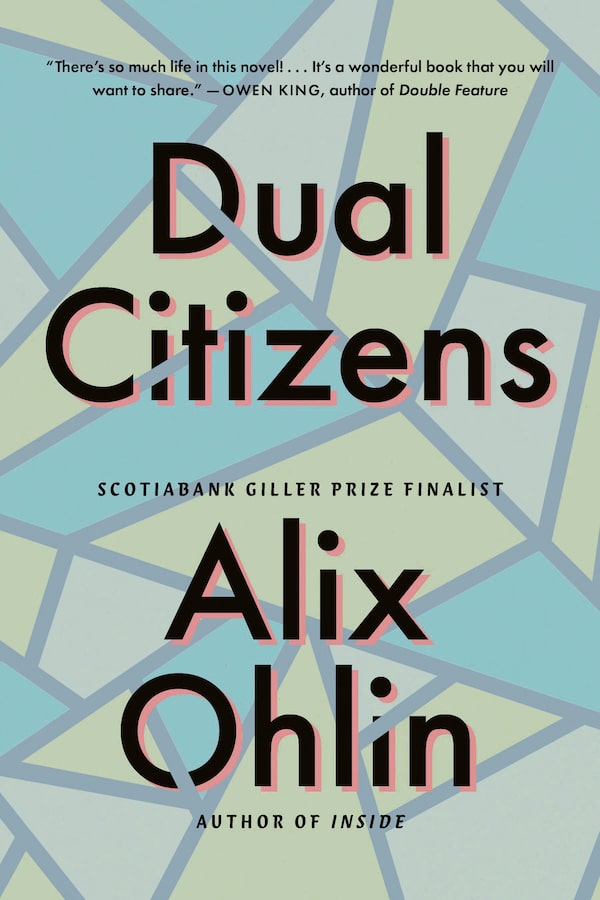
Supplied
- Title: Dual Citizens
- Author: Alix Ohlin
- Genre: Fiction
- Publisher: House of Anansi
- Pages: 274
The potential, the striving, the would-be, the decidedly not, the reluctant, the accidental, the planned, the step, the embittered, the proud, the crazy, the painfully sane, the sorrowful, the joyful, financially precarious, secure, too old, too young, missed, fled: In Alix Ohlin’s books, watch out for the mothers.
This is another way of saying watch the women and girls – but with a difference. While other Canadian writers have authored novels examining motherhood (Claudia Dey’s Heartbreaker is one recent example that jumps to mind) or abortion (see Nelly Arcan’s Hysteric), it’s hard to think of another who has so wholly made reproduction her authorial field.
Amid a wave of U.S. states passing bills prohibiting abortion – in turn, emboldening some anti-choice politicians in Canada – Ohlin’s latest novel, about the attractive and repulsive force of motherhood, certainly seems timely. It would be a mistake to consider Dual Citizens a response to the news of the day, however. Motherhood and its flipside, a woman’s choice or lack thereof, has been Ohlin’s preoccupation since the beginning.
Consider her 2006 debut, The Missing Person, about Lynn Fleming, a historian of feminist art dragged home to Albuquerque by her travel-agent mother. Among “a mother lode of memorabilia” from her childhood home, Lynn rediscovers two paintings, one of them in the form of a “reverse pieta”: where traditionally a pieta depicts Mary cradling the dead body of Christ, this painting shows a baby-like man holding his scowling, possibly dead mother. “As a portrait of motherhood, it was less than idealized,” Lynn concludes, with understatement. Or Ohlin’s second novel, Inside, shortlisted for the 2012 Scotiabank Giller Prize, which could be read entirely through the lens of pregnancy. Ohlin writes of one character: “Rarely, if ever, did she think about those weeks when she herself had been pregnant, or imagine how old that child would be now if she had decided to keep it. She remembered feeling no physical or emotional change back then, only the sheer sensation of panic, like a bird trapped in a house, flapping her wings in frenzy and desperation.”
Which brings us to her new novel, Dual Citizens, and the question of what about this subject Ohlin considers unexamined. It begins, of course, with a mother: disinterested, absentee Marianne, raising her two daughters, half-sisters Lark and Robin (the “dual citizens” of the title), in 1980s Montreal. Here is the first major difference from Ohlin’s prior work: Motherhood represented as not just difficult, but for Marianne, a burden.
It’s the older sister, Lark, who narrates, with decades of hindsight, yet there are times her adult self still struggles to comprehend Marianne’s motives:
“She considered it a form of imprisonment to say where she was going or why, and as the young mother of two young children she’d already been imprisoned enough. At least that’s what I think now. At the time, I thought she resented us, and contrived one reason or another to be away from us as much as she could. Which may also have been true.”
For anyone who has lived with this type of person, Marianne isn’t such a puzzle, at least no more so than any other narcissist. Was she inherently this way, hot-cool, alternatively hurtful and tender, easy with meeting a camera’s gaze and the life of the party, but quick to anger, spurning her daughters’ affections? Or was she pushed in this direction by circumstance? “Perhaps she was immature because she’d missed out on her own youth,” Lark ponders.
I hear you, reader: “Blaming the mother – isn’t that the oldest trick around?” But that’s not what this is. Lark is surprised years later when someone describes her childhood as unhappy. Except during a brief, hormonal spell, she doesn’t consider herself a victim. “It was strange, yes, in the sense that we mostly raised ourselves,” Lark recalls, but the significance of Marianne’s physical and emotional distance is how it draws the sisters together. “My sister and I had each other, a union of separate but conjoined strengths.” Lark becomes a kind of surrogate mother to her younger sister. What is surrogacy? Ohlin’s work up to this point focused almost entirely on biological motherhood. With Dual Citizens the focus shifts to more nebulous forms of female relation.
Everything mentioned above is from the first half of the novel, a section labelled “Childhood,” which ends with a crisis, a psychological and narrative break. Perhaps unsurprisingly, given the overriding theme of Ohlin’s oeuvre, the latter half of the novel is called “Motherhood,” although who the mother is remains unclear for a long time. I suspect that in Ohlin’s work, motherhood is a life stage more than the state of actually parenting a child. That would explain why, even in the stories of characters with no desire for kids, motherhood remains for Ohlin this repeated point of fascination. Something like how Lark eventually describes Marianne: “a ghost I kept inviting to haunt me.”
Expand your mind and build your reading list with the Books newsletter. Sign up today.